Once a buyer has narrowed their choice of materials used to build the trailer, a common decision is how the animals stand in the trailer. With options such as straight load, single file, slant load, head-to-head, rear-facing, and box stalls, the choice can quickly get confusing. Especially when EACH manufacturer or dealer is telling you that their way is the best and most comfortable for your animal. Does it really matter?
I should preface here by saying that I am definitely not offering a scientific viewpoint. There are articles out there, most written by manufacturers (which I don’t give a lot of credence to, personally) attempting to make their product unique. I admit it’s a good sales tactic, but I want to know what is actually best for my animals before I buy. So, over the years, I have simply watched my animals. The following is just my observations.
There are several ways to know how comfortable the animals are in a trailer. You can watch them through the trailer’s front window as you ride down the road (assuming you are the passenger–I wouldn’t recommend it if you are the driver!!). After loading your animal, consider how long it takes them to find a position and be still, and note what position that is. Usually there will be some adjustment after the vehicle starts moving, but overall, when the animal has found a comfortable position, they will appear more relaxed in their expression as well. Another way is to check the animal AFTER driving a distance, as the animal will have settled into the position most comfortable for them during the movement. In my opinion, these are excellent indications. One thing that can make this type of observation difficult, however, is when horses are tied into a trailer, which limits their movement considerably.
Like most “responsible” horse owners, I also used to swear by tying my horses in the trailer. I spent big bucks on emergency release tie snaps, bungee cord tie straps, and more. Then, as time went by, I began training wild horses for the BLM (Bureau of Land Management). This involves going to the holding facility, running a wild, untouchable, frightened horse through a chute and into the trailer, and slamming the rear door shut. If you tried to tie one of these horses, you’ likely get yourself or the horse injured or killed. Therefore, the horses are left loose in the trailer. I have used a 16 foot bumper pull, with one horse using the entire floor space; I have used the same trailer with 2 horses divided by a center gate, creating 2 box stalls; and I have used a 4-horse slant gooseneck model, with all dividers opened so the horse had the full floor space. In addition, I have hauled semi-tame horses on multiple occasions, with up to 3 loose in the 16-foot trailer (only if they got along well!). What I quickly noticed, is that in EVERY SINGLE CASE, the horses settled almost into a standard, slant-load position, with their head facing toward the front and center of the road. With wild horses and horses not experienced with loose trailering, I could often feel a bit of trailer movement and sway in the first couple minutes as the horse moved around to find its preferred position. They always settled in the same position though, no matter what type of trailer I used. As long as they had the space to turn around, they settled into that slant position, and would stand there–sometimes for hours at a time. Another interesting observation was that, if hauled alone, horses seemed to prefer to have space around their body and not touch any wall, but if hauled with other horses and no divider, the horse toward the rear would always have his head and shoulders touching the horse in front.
On the other hand, I have NEVER seen a horse volunteer to face the rear, the outside of the road, or stand facing directly forward. I can’t explain the preference for the center of the road, unless it has simply to do with the slope of the road, allowing the center to be more “uphill” than the outside. It makes total sense though, that they would not stand facing either forward or backward. Think about standing on one of those fast, people-mover trains. When the car first starts, there is a force that pulls you backward. As it travels, it tends to rock you from side and side. As it slows, momentum pulls you forward. The same happens in a trailer (yes, I have ridden in one around the property to feel it and to listen to the noise it made). When you are on that subway car, it is nearly impossible to stand, facing forward, with your feet together. Rather, you will naturally spread your feet and angle your body to minimize those forces. When I used to take martial arts, we were taught that the most stable and secure stance was with our feet at opposite diagonal corners of an imaginary square. I believe horses are doing the same thing. They angle their body with their head and shoulders upward, and the slant position allows more even “spread” from their front hooves to the rear hooves to allow them to most efficiently resist those forces from every angle.
While I haven’t personally hauled cattle or hogs, I don’t believe this preferred position is limited to horses. I have observed many a cattle and hog truck driving down the highway–you know, the semi-trailer or long stock-trailer type that has holes or slats which allow you to easily see the animals. In almost every instance, these animals are loose in the trailer, but almost always in that same slanted position. The only exceptions I have witnessed are when the animals were packed so tightly that they had trouble turning around, in which case, I would see most animals in the preferred position, and a random one facing the opposite direction, securely “blocked” by the animal on each side.
Smaller animals, on the other hand, seem more comfortable just being able to move around. Goats, poultry, dogs, etc., are seldom seen standing or laying in the same position for long periods. They usually move around quite a bit, exploring the trailer, shifting from side to side to lie down, and so forth. Goats also seem to prefer laying down against a wall to help stabilize themselves.
That being said, my ideal trailer would depend on what I was hauling. The particular design of the trailer (straight, slant, or box) can affect the overall length and weight of the trailer, so it is something to keep in mind. If I was hauling horses, I would want a slant-load (forward facing toward the center of the road) or an open space such as a stock trailer or box-stall large enough the horse can turn around in. I do believe horses will learn to lean on the slant dividers, if you use them, but initially, they naturally depend on their feet to maintain balance. For cattle or any other large animal, I would aim for the open space or box stall set up. I would not tie an animal if it was traveling alone with space to move around, or if there was a secure floor-to-ceiling divider between stalls. If I was using a slant trailer with multiple horses, however, and the divider had the typical “head-gate” type divider, I would tie the horse. I have seen playful or nervous horses over the years that leaned back and stuck their head over the rear slope of that head-gate, get stuck, and panic, or lean way down and reach their heads under the divider to pick on their neighbor. In this case, it is safer to tie.
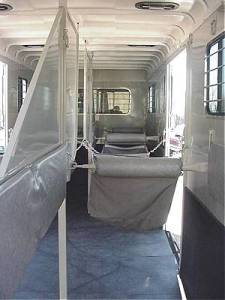
Trailer with center and rear load option, and head-to-head position. The horses in front are backed into their stall, while the horses in back can either be backed in or walked in from the rear entrance.
Source: Internet Stock Photo
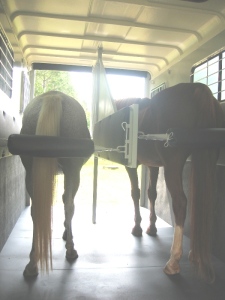
Horses in a rear-facing position. Notice the secure butt-bar, to absorb the horses weight if he leans back.
Source: Internet stock photo
For pretty much all other livestock I can think of right now, I would choose an open stock trailer design, or at least a box stall design, to give the animals freedom to position themselves how they feel most comfortable.
Now, I understand that in some cases, a situation may require the purchase of a single-file straight load, a 2-horse straight load, a rear-facing, or even a head-to-head (where the two horses in front face the rear, and the horses in back face the front). You have to do what you have to do, and the animals will usually adapt. Even then however, there are considerations. First, you should tie the animal in all these positions to prevent trouble. If you must tie, I highly recommend utilizing a trailer tie with a quick-release snap for emergencies. Secondly, make sure the dividers on the side of the animal do NOT go all the way to the floor. Ideally, they would be no lower than the horse’s knee or hock area, and preferably even higher. You must give the animal room to spread his feet from side-to-side to help him stabilize against the forces he will experience during motion. When trying to maintain their balance during the side-side swaying motion of the trailer, I have often seen even the calmest of horses leave their hoof prints on their neighbor’s side of the divider. They can really spread those feet when necessary!
If you plan to primarily haul horses, consider a trailer that allows the horse the ability to stretch his head and neck down. Horses clear their sinuses by lowering their heads and blowing hard. They also lower their head to stretch. My absolute LEAST favorite trailer is the standard, every-day, 2-horse straight load with the front “manger” that has a tack storage area underneath. I hate these because the horse’s head is stuck into this tight little space, which most people fill with hay. Once the trailer gets moving, that hay and dust start blowing around in that little space. Not only can the horse not escape it, but he is forced to inhale it. Then, when his sinuses are full of this stuff, he his unable to lower his head to blow the sinuses clear. These problems can increase the risk of respiratory issues such as shipping fever after the trip. Just a bad situation all around. In recent years, the few times I was forced to use such a trailer, I would carefully wipe out the manger area, and not put any hay in. This at least helped reduce the blowing debris that could be inhaled.
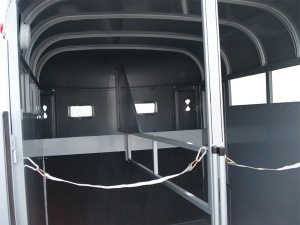
Standard 2-horse, straight load trailer with mangers in front and flexible strap in the rear.
Source: Internet Stock Photo
A secure alternative is to get a straight-load trailer with padded chest bars. My Cotner trailer had these, and they worked beautifully. A “short wall” they can hang their head over would work too, though I haven’t seen many of these. In fact, I found a side advantage of the horse loading much easier because the front of the trailer tends to be more open and inviting. You have the option of hanging a hay net/bag if necessary, but the air is not trapped where the horse has to breathe it, and he can easily lower his head over the bar. Some trailers with this option have plenty of space in front to add a couple saddle racks and a trunk, while others may be limited in storage space. However, I would rather put the saddle in the back of the truck if necessary to ensure the health and comfort of the horse.
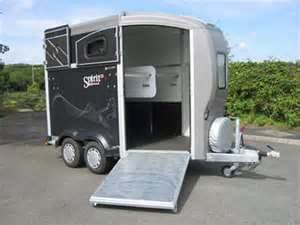
2-horse trailer with chest bars and divider giving plenty of leg-spread room.
Source: Internet stock photo
Finally, I am going to refer strictly to horses for a moment, since I am more familiar with this area, but I’m sure similiar issues can apply to many other animals. You want to ensure that the trailer fits your horse and the number of horses you plan to haul. A horse should always have a good experience in a trailer, and the more comfortable they are, the better the experience will be. I have seen some horses really crammed into trailers. I have seen 3 horses crammed side-by-side in a straight-load position, so that 5-6 horses could be squeezed into a standard stock trailer–and they weren’t ponies either! I have seen saddled horses crammed 5-6 in a slant-load position in a trailer intended to haul no more than 4 horses. The worst case I saw though was a very tall, off-the-track thoroughbred whose owner went and bought a used, standard, 2 horse, straight-load with a manger in front in order to attend the event at which I met them. Fortunately for the beginner owner, this horse had the most incredibly amazing disposition, and tolerated a lot!! As I observed on the day we left, this poor horse walked into that trailer, with the manger literally STUFFED with half a bale of hay (no exaggeration!), meaning there was no head room. He pressed his head down one side of the hay, and squeezed his tall, lanky body into the trailer. His high withers were almost touching the top of the trailer as he rounded his back to squeeze his hindquarters into the trailer. The owner then firmly pushed the butt-bar into the horses rump in an attempt to latch it securely. I’m telling you, this was an awesome horse!! Nonetheless, we tried diligently to kindly convince this new horse owner to consider a new trailer. The owner was taking him home from the event–an 8 hour drive, just for the record! I was borrowing a truck and trailer and going several hours in the opposite direction, or I would have offered to give the horse a lift. I can only hope the owner took our advice when he got home. Fitting the horse to the trailer isn’t really an exact science; rather, just observe. If the horse looks comfortable, can raise his head around 8-12 inches higher than his withers (more is great or you might want to use a head bumper), can freely move his head slightly side to side, has at least a few inches between his body and the divider on each side and behind him, and can easily stretch his neck and head downward, he probably is just fine. One discovery we made during our search is the fact that a trailer height is typically measured on the very back, where the door opens. It is measured from the top of the bottom frame bar to the bottom of the top frame bar. If, like most trailers, the top frame bar hangs lower than the rest of the ceiling, you may actually get more height. For example, a number of trailers we looked at were classified as 6’6″ high, when inside the trailer, they were actually closer to 6’8″ high. It’s worth noting, expecially if you are the type that hauls animals wearing tack.
Before I totally close this thought, in a straight-load trailer, you may want to consider a butt-bar rather than a chain or cable. I have seen the back doors actually bowed and warped from a horse leaning back on his chain, or directly on the door itself. The bar, on the other hand, takes the weight of the horse if he leans back or sits a bit, thereby protecting the doors. I recently heard rumor that many manufacturers are installing more chains or straps and fewer bars due to the “inconvenience” of horses leaning on the bar, making it difficult to open upon arrival at the destination. In my opinion, this is a training issue. The horse needs to step forward when I ask him to, rather than lean on the bar when I am trying to open it. I would not want to risk damage to my trailer simply because I was too lazy to train the horse. Also, by adding a little extra grease to the latch of some designs can help prevent stuck bars.
In closing, comfortable animals make for happy animals, and allowing them the ability to stand (or lay) comfortably will significantly help reduce their stress level, thereby automatically improving their health and dispositions upon arrival.

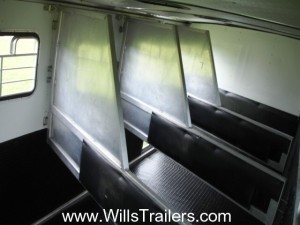
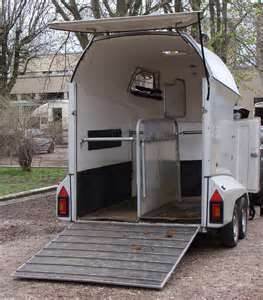
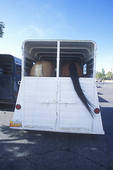
Leave a comment